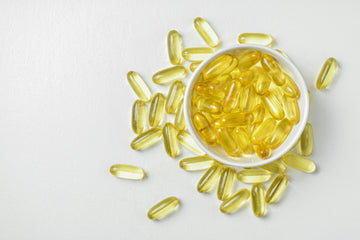Taking omega-3 correctly - when is the best time of day?
Omega-3 fatty acids are essential nutrients that offer numerous health benefits - from supporting heart health to improved brain function and anti-inflammatory effects. But many people wonder: when is the best time to take omega-3s to get the maximum effect?
Why does the time of intake matter?
The time of day at which omega-3 is taken can influence its absorption and utilization. Digestion plays a particularly important role here: omega-3 fatty acids are fat-soluble, which means that the body can best absorb them together with meals containing fat.
By taking omega-3 at the right time of day - namely during or directly after a fatty meal - you can significantly improve absorption and thus benefit to the maximum from the positive health effects.
The ideal time of day for omega-3
The best time of day to take omega-3 is during or immediately after a main meal that contains healthy fats. Many people take omega-3 with their breakfast or dinner, as these meals usually contain the necessary fats that improve absorption.
Morning or evening - which is better?
Morning: Ideal for an energizing start to the day. Omega-3 capsules can be combined well with a healthy breakfast, for example with yogurt, nuts or avocado. Omega-3 can also contribute to greater mental clarity and concentration in the morning.
In the evening: Can help to regenerate the body overnight and reduce inflammatory processes that often occur more frequently at night. Some users also report that they sleep better when they take it in the evening, as omega-3 can have a calming effect on the nervous system.
Take omega-3 with or without food?
Omega-3 capsules should always be taken with food, ideally with healthy fats such as olive oil, avocado or oily fish, to ensure optimal absorption. Taking them on an empty stomach significantly reduces bioavailability.
Optimal dosage for best effect
The recommended dosage is usually around 250 to 500 mg EPA and DHA per day. You can easily take this dosage via high-quality omega-3 capsules, which contain precisely dosed amounts.
Avoid mistakes during ingestion
A common mistake is to take the capsules on an empty stomach or with meals without sufficient fat content. This significantly reduces the absorption capacity of the fatty acids. Another mistake is to take them irregularly. Omega-3 fatty acids develop their positive effect best when taken continuously.
Scientific findings on omega-3 intake
Studies show that regular intake of EPA and DHA can reduce the risk of cardiovascular disease, promote cognitive function and reduce inflammation in the body. According to a study from 2020, omega-3 fatty acids make a significant contribution to reducing chronic inflammation and provide long-term support for brain and heart health.
Frequently asked questions
Can you overdose on omega-3?
An overdose is unlikely if the recommended dosages are adhered to. Doses of up to around 3 grams of EPA and DHA per day are considered safe, but higher doses should always be discussed with a doctor. Possible side effects of higher doses can be digestive problems or an increased risk of bleeding.
Is omega-3 also suitable for vegans?
Yes, omega-3 fatty acids are also available from vegan sources. Algae oil in particular offers an excellent alternative to fish oil, as it is rich in EPA and DHA. Vegans should make sure to choose omega-3 capsules that are explicitly made from algae oil.
Do they interact with medication?
Omega-3 fatty acids can influence blood clotting. People taking blood-thinning medication should consult their doctor before taking large amounts of omega-3 to avoid potential interactions.
Conclusion: regularity beats time of day
More important than the exact time of day is the regularity and the combination with a high-fat meal. Therefore, choose a time of day that fits in well with your daily routine and stick to it consistently. Your body will benefit from the positive effects of these valuable fatty acids in the long term.
Our recommendation
Image Credits: Photo by Aknarin Thika: https://www.pexels.com/de-de/foto/gesund-kunst-gelb-mockup-16776311/




